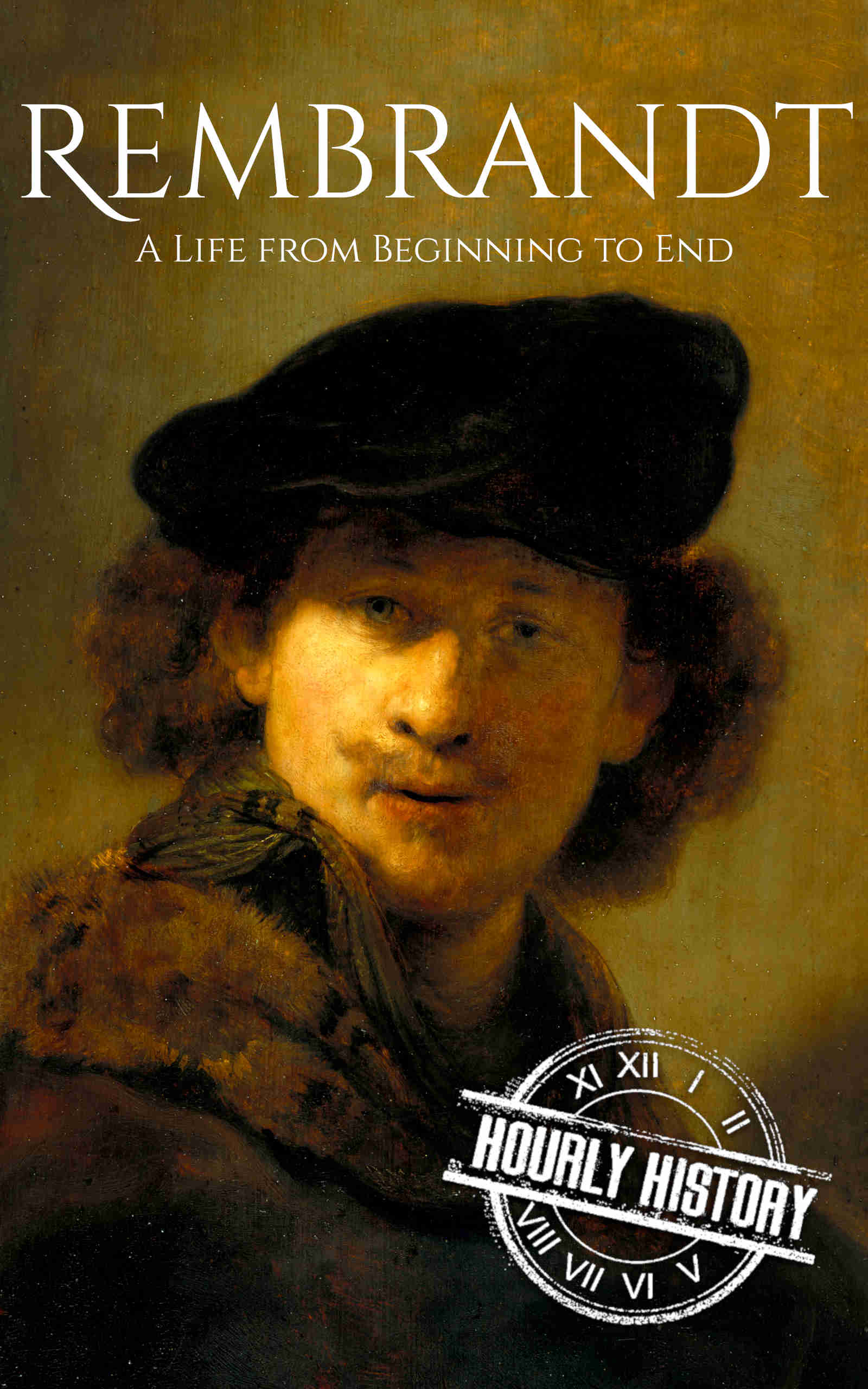Discover the remarkable life of Rembrandt...
Dutch painter and printmaker Rembrandt Harmenszoon van Rijn is considered one of the greatest artists of all time. As a painter, he never considered glamorizing what he saw, and he was a master of creating extraordinary scenes with light and shadows. His paintings were unique for their ability to depict action and moods.
Sadly, having a mistress and spending recklessly went far to ruin his reputation during his lifetime. Rembrandt died penniless and was buried in a pauper’s grave.
Discover a plethora of topics such as
- Born to Paint
- Death of His Wife
- The Night Watch
- Scandalous Love Life
- Financial Ruin
- Late Life and Death
- And much more!
So if you want a concise and informative book on Rembrandt, simply scroll up and click the "Available at amazon" button to avail this bargain!
Timeline
1606
Born in Leiden
Rembrandt, considered one of the foremost artists in the world, was born on July 15, 1606, in Leiden, the Dutch Republic. He was the son of a prosperous mill owner.
1620
Education
At an early age, Rembrandt was enrolled in a prestigious Latin school instead of going into a trade like his father and siblings. When he turned 13, he continued his education at the University of Leiden. We can assume that this was the wish of his father and not his own, as the mayor of Leiden recorded that Rembrandt had no interest in studies but was entirely obsessed with painting.
After leaving the university early without graduating, young Rembrandt joined the studio of Jacob van Swanenburg to learn the fundamentals of painting.
1624
Apprenticeship
Following his time with Swanenburg, Rembrandt moved to Amsterdam and worked as an apprentice for another, more established artist named Pieter Lastman. Lastman’s usage of light and shadows would remain the predominant influence on Rembrandt’s paintings throughout his life.
1625
Opening his own studio
Following his internship in Amsterdam, Rembrandt returned to Leiden and opened a studio with fellow artist Jan Lievens. Rembrandt’s first major painting here was a reproduction of Lastman’s The Martyrdom of St. Stephen. Rembrandt called his own painting The Stoning of St. Stephen, and it became the first painting he ever signed.
1629
Important commissions
In 1629, Rembrandt came to the attention of a wealthy art connoisseur named Constantijn Huygens. Thanks to his patronage, Rembrandt secured several important commissions from the court of The Hague. One such commission was from the Prince of Orange, who ended up acquiring seven paintings, now known as the Passion of Christ series.
1631
Success
By 1631, Lievens had moved to London, and while Rembrandt kept the studio in Leiden, he was now spending a lot of time in Amsterdam.
Before long, Rembrandt became a well-known portrait painter, highly favored by Amsterdam’s aristocrats. His portraits were his first bestsellers and provided him with a comfortable life. In contrast to many other painters, Rembrandt enjoyed success while still in his twenties.
1632
The Anatomy Lesson
One of Rembrandt’s most interesting portraits of this period was The Anatomy Lesson, which depicts a group of men engaged in an autopsy. This was very unusual as, normally during this era, portraits were of individuals or families in stiff poses.
1634
Marriage
In 1634, Rembrandt married Saskia van Uylenburgh, the cousin of his landlord. Saskia was an excellent catch for the bourgeois Rembrandt.
Prior to meeting Saskia, Rembrandt had not painted many women. After he married her, however, he began painting more women, especially women from the Bible, for which he sometimes used Saskia as a model.
One interesting painting that Rembrandt made around this time was The Prodigal Son in the Brothel, a self-portrait of him and Saskia.
1642
Death of his wife
Rembrandt and Saskia had a true love match, their happiness only shadowed by the death of three of their children. They had been married for eight years when Saskia died in 1642, leaving Rembrandt with one son, Titus. Rembrandt was truly devasted by the loss.
That same year, Rembrandt completed one of his greatest masterpieces, The Night Watch.
1643
Scandals
In 1643, Rembrandt entered into a relationship with his son’s wetnurse, Geertje. Saskia’s family was outraged and made clear that should Rembrandt marry Geertje, he would lose Saskia’s inheritance.
Six years later, Geertje left the household when Rembrandt entered into a relationship with his new housekeeper, Hendrickje. Geertje subsequently sued Rembrandt for breach of promise (at the time, a man’s promise to marry a woman was considered a legally binding contract), and the court awarded her an annual sum of 200 guilders.
By the following year, however, Rembrandt petitioned to have Geertje placed in an asylum because she had reportedly pawned some jewelry that had belonged to Saskia. She was sentenced to twelve years’ confinement.
1649
Hundred Guilder Print
Most people today think of Rembrandt as merely a painter, and all too frequently, his prints and etchings are overlooked. One of his most famous etchings is called Hundred Guilder Print and was made around 1649. M. E. Wieseman, the Dutch museum curator, referred to this etching as a “technical tour de force, incorporating an enormous diversity of printmaking styles and techniques.”
1654
Cornelia was born
Rembrandt and Hendrickje’s out-of-wedlock daughter Cornelia was born in 1654. As a result, Hendrickje received a summons to the Reformed Church, where she was chastised for her illicit behavior. Despite the public judgments against her, Hendrickje remained with Rembrandt, considering herself his common-law wife.
1656
Financial ruin
Rembrandt had been living beyond his means for many years, especially since the purchase of his house in Breestraat, which he was unable to pay for. With creditors hounding him, he filed for bankruptcy in 1656. As a result, the court ordered an inventory of all his belongings, which were to be put up for sale to repay his debts. This included his own paintings and paintings from his students, as well as works from other artists.
1660
Losing his house
In 1660, Rembrandt’s house was sold by order of the court since he still owed considerable money. The fact that Rembrandt had been irresponsible in his personal dealings was regarded as a serious social flaw, causing his standing in the artistic community to drop.
Foolishly, Rembrandt continued to accumulate debts even after he lost his house. His reputation was, understandably, in tatters. Interestingly, his fame in Italy, where perhaps less was known about his personal habits, had grown.
1663
Death of Hendrickje
During the final years of Rembrandt’s life, he concentrated on what he did best—painting. Hendrickje and Titus handled all business matters, which made life more pleasant for everyone. Sadly, Rembrandt’s protector and soulmate Hendrickje died in 1663, leaving him quite alone.
1668
Final painting
One of the last paintings by Rembrandt before his death is The Return of the Prodigal Son. One art historian said that this painting was “a picture which those who have seen the original in St. Petersburg may be forgiven for claiming as the greatest picture ever painted.”
1669
Death in Amsterdam
Rembrandt passed away on October 4, 1669, aged 63. He was not ill at the time, but he was very much alone. Titus had died one year earlier, and Cornelia was the only family he had left. Sadly, his pauper’s grave was eventually dug up and his remains destroyed, a common custom for the remains of the poor. As a result, one of the world’s greatest painters has no gravesite.
Age of death: 63
Place of death: Amsterdam
Cause of death: Unknown


